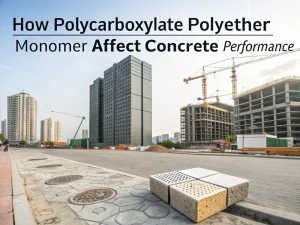Blog
Polycarboxylate ether (PCE), the latest generation of high-performance concrete admixtures, possesses unique properties that make it indispensable for manufacturing strong, feasible, and durable concrete in all types of buildings, from skyscrapers to prefabricated components. But what are the key properties of polycarboxylate ethers, and how do they change the performance of concrete?
This article will delve into the seven core properties that define PCE, explain their working principles, and their profound impact on concrete.
One of the most decisive characteristics of PCE is its designable molecular structure. PCE molecules are composed of the following parts:
A negatively charged skeleton (usually polyacrylic acid) is fixed on cement particles.
Long and flexible polyether side chains (such as the “teeth” on a comb) extend into the surrounding concrete matrix.
This structure is not fixed – manufacturers can adjust it:
Skeleton length and charge density (used to adjust the adsorption strength on cement).
Side chain length and density (used to control steric hindrance or physical repulsion between particles).
Impact on concrete: This customizability allows PCE to “customize” specific projects, for example, formulas with longer side chains can extend processability, or formulas with shorter skeletons can accelerate strength development.
This is also a key performance feature of polycarboxylate ethers. PCE’s most famous feature is its ability to reduce the moisture content in concrete by 25-40%, far exceeding that of traditional superplasticizers (15-25%).
Working principle: The powerful steric hindrance effect can efficiently disperse cement particles, releasing ineffective water trapped in flocculent aggregates, making it a free-flowing lubricant.
Impact on concrete: A lower water-to-cement ratio will result in denser concrete, increasing compressive strength by 20-50% and enhancing resistance to water, chemicals, and freeze-thaw damage.
This is one of the most significant advantages of polycarboxylate ethers compared to previous-generation technology.
Traditional additives quickly lose their workability (slump drops by 50% within 1 hour). However, PCE can still maintain a slump of 80-90% for 2-3 hours or longer.
Even during the hydration process (when cement naturally hardens), long side chains can maintain physical separation between cement particles.
Impact on concrete: Perfectly solves the problem of long-distance transportation of commercial concrete and drying out while waiting for pouring on construction sites. It ensures the smooth progress of construction and avoids quality hazards caused by illegal water addition on-site.
PCE is highly effective at low concentrations, typically ranging from 0.2% to 0.8% by weight of cement (compared to 1-3% for traditional additives). This attribute originates from:
It has a strong adsorption effect on cement particles (thanks to the charged skeleton).
Long side chains, with each molecule covering a larger surface area, maximize dispersion.
The impact on concrete: reducing material costs, and more importantly, avoiding side effects such as drying shrinkage and delayed setting that may occur due to high chemical content.
The combination of PCE with sustainable additives, such as fly ash, ground blast furnace slag (GGBS), and silica fume, has shown promising results. Silica fume is a mineral byproduct that replaces cement (reducing carbon emissions).
Unlike some older admixtures, PCE does not react negatively with fly ash or slag, ensuring consistent workability throughout the project. The side chains of PCE help to evenly distribute mineral additives, enhancing their contribution to strength and durability.
Impact on concrete: Achieving environmentally friendly concrete mixtures with low cement content, consistent with green building goals.
The effect of PCE on the setting time of concrete is adjustable, which is a key characteristic that adapts to project conditions:
Standard formula: Neutral, has almost no effect on solidification (very suitable for general construction).
Modified version: Can be designed to accelerate solidification (for cold weather projects) or delay solidification (for hot weather projects) without sacrificing processability.
Impact on concrete: Prevent delays caused by concrete setting too quickly (not feasible) or too slowly (resulting in an excessively long curing time).
PCE enhances long-term durability through various features:
Reducing porosity: By lowering the water-cement ratio, PCE can produce denser concrete, reduce water channels, and resist corrosion of steel bars.
Uniform hydration: The uniform dispersion of cement particles ensures consistent curing and minimizes shrinkage cracks to the greatest extent possible.
Chemical resistance: A denser mixture (resulting from PCE water reduction) is more resistant to salt, acid, and industrial chemicals, which is crucial for marine structures or wastewater facilities.
The polycarboxylate ether properties – from their customizable molecular structure and high water reducing ability to excellent slump retention and compatibility – make them the cornerstone of modern concrete technology. These features address long-standing challenges in architecture, achieving a more robust, feasible, and durable blend that meets the needs of both skyscrapers and sustainable infrastructure.

How Polycarboxylate Polyether Monomer Affect Concrete Performance
Blog How Polycarboxylate

How Polycarboxylate Superplasticizer Interacts With Slag In Concrete
Blog How Polycarboxylate